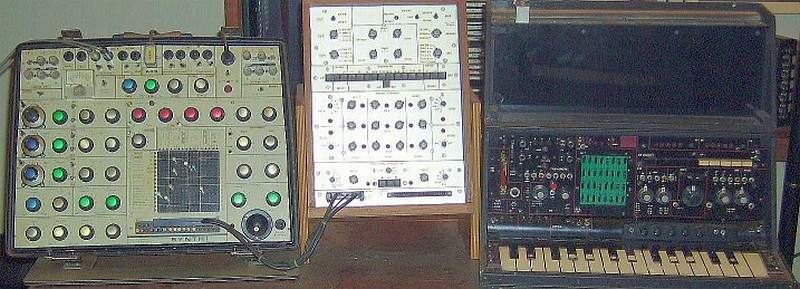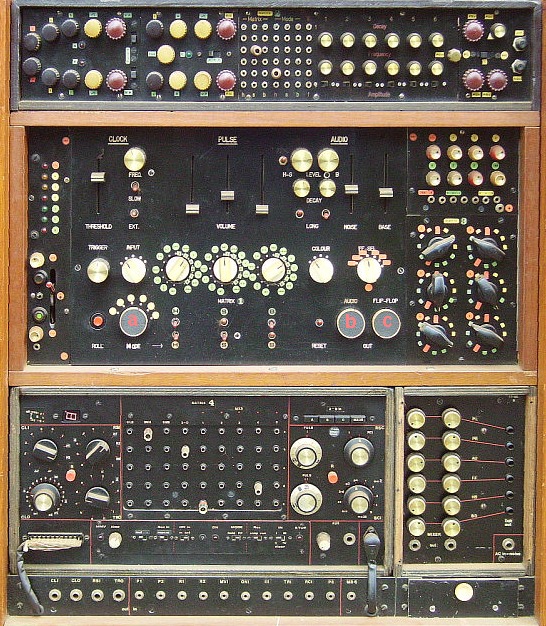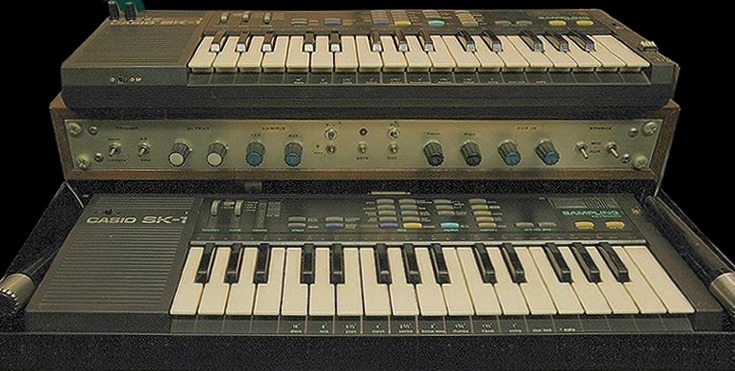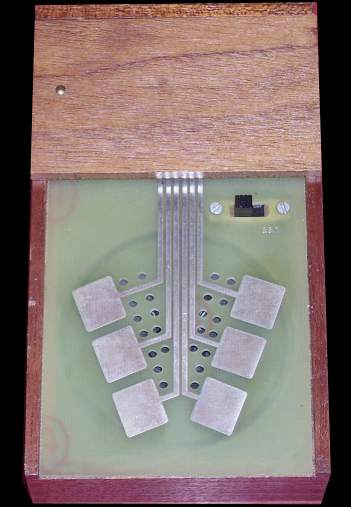Twin Casio SK-1 sample keyboards Sampler with the Texas Instr. TMS 3477 IC
The Cracklebox ('Kraakdoos')
E M S S y n t h i A K S

Picture of the outstanding designer with his Synthi : David Cockerell
A previous model other view - A more recent model : the AKS 80
Leaflet of the table version : VCS3 mark II + specifications
|
In the suitcase is the analog synthesizer, in the lid is a touchpad keyboard with a sequencer. The synth has different modules, that can be connected via a patchboard (X-Y matrix). All audio and control voltages ins and outs are available. The sequencer is a combination of analog (opamps) and logical (TTL-ports) circuits with a dynamic memory of 256 steps of 6 bits (one bit acting as a trigger-pulse for the envelope-generator). To pianists and organ-players : this is not a plain 'keyboard' ..! Although the 30 touch-keys have a black and white piano-model, they're just 'control'. Because of the versatility of voltage-control the key at the left can be as well the highest note available, or the 30 keys have a range 3 notes or of 9 octaves .. Also nice : a 'random'-key and four keys for binary transposition of the sequence. Outputs : 4 voltages : 'Sequencer' and 'Real-time' (5-bits DAC's), 'Dynamic' and one trigger pulse. |
The complete set of my modified Synthi A TKS

About the electronic cq functional modifications of this instrument
Some sound examples (OGG format), short versions of own work :
Witches' Woe Don't kow Mu-Do Flat neuroses Flip Flop Drive (solo) Little Paper Boat
Albums with compositions by Synthi users including me : The Synthi Group Vol 1 The Synthi Group Vol 2
33 rpm floppy vinyl record, EMS promo, included with album 'Trios' by Tristram Cary (voice-over) : side A - side B
Relevant Links :
Richard Davies Electronic Music Studios Hinton Instruments
Article about the EMS history Pin's EMS site
The Randrum

|
Originally a small analogue drumcomputer, consisting of a box with the three knobs, seen in the centre section with the red a-b-c. One switch for six different patterns of 16 steps, with 3 sounds : basedrum, snare and hihat. Two potentiometers for speed and volume. It started with the need for an external clock, so it could be synchronised with the AKS sequencer. Then a need for more control over the 3 sounds, and the access to the different (clock)pulses. This led first to the building of the middle section, including a clock input for analogue signals, with threshold controls, noise and low-sine controls, and a matrix with switches of the pulses involved, to create other patterns. With the conversion of the analogue pulses to a standard 5V TTL level, it became obvious to use logic components to add counters, dividers, etc. Plus an external reset for a cycle other than 16. This resulted in this contraption with 99 controls .. In the meantime, the audio-part of the machine is set to the background and the pulse-manipulation has become the main interesting thing. It can be used for feedback to the Synthi as trigger-pulses. |
Closer views : Top L Top R Center L Center R Bottom L Bottom R Back view..
Sound examples of the Randrum coupled with the Synthi AKS :
One of these Imps 3 part A
The Casio SK-1 twins

|
The first cheap consumer product (almost a toy) to have sound-sampling capability with a built-in microphone, plus, nice enough, a line input. Plus memory to save a sequence. So I managed to get 3 of them. Two of them were used to construct this twin set. The reasoning for modifications : The connections of the keyboard. One can't have both microphone and line connected as a sample input because the microphone plug overrules. While it appears to deal with one single input of the system, with the line-signal dampened by a 220 K resistor. So the need for an (external) input switch between line-in and microphone, without pulling plugs all the time. The quality of the sampling was apparently based on the use of speech, in favour of duration. So the clockspeed of the processor was set relatively low, with a slight range, tunable with a screwdriver from the bottom of the case (a very stupid design). This clock-generator was a simple R/C combination attached to the processor. So I replaced that with a logic VCO, the 74LS624, to have a larger range and fine-tuning. Instead of some three semi-tones, the range is now almost 3 octaves. Of course with higher ranges resulting in lowering maximum duration of a sample. Secondly, every time the sampling was finished, the thing creates a loud beep from the percussion channel. Awful, when you are playing on a stage via 200 watts amps ... It appeared to be the percussion output, which is not always used. So I inserted some switches, and added leds to replace the beep by a visual indicator of the sampling process. Thirdly, the SK-1 has an inbuild circuit to shut off the power after some minutes, if the thing isn't touched. The APO. A bit too efficient, because if one has some sequence in the memory, and is then busy with some other activities for a while, it can be a loss of work if the power is shut off, so the RAM is empty again. I've searched a while for an electronic solution within the existing circuit, but couldn't find any. ( In the meantime I have found a solution to disable APO) So I ended up with an opportunistic solution : activating the 'fill-in' button once in a while, manually or with a switch. A key with the least possibility to cause any sound on the moment. As for the Twin concept : This is done to create a so-called ping-pong situation, where the audio-output of one sampler can be connected to the sampling-input of the other and vice versa. This can mean that one plays a certain chord on one keyboard, sample this on the second one, where then the complete chord is available under one key. And so on. Or play a sequence of notes, and assign this sequence-sample as one note on the other keyboard. |
More Twin Details the SK1 Service Manual the SK1 Owners Manual
More SK1 bending by Electri-fire and
91 sound samples from the original Casio compact cassette Some improvisations with the Twin set
Sampler built around the TMS 3477

|
This device is designed around an integrated circuit from Texas Instruments. Originally the I.C. was meant as a recorder for telephone messages, so, as with the Casio SK-1, it had a rather low-frequency R/C clock, to prefer a long duration and take poor quality for granted. Again I replaced this clock with the TTL-VCO LS624, and it appeared that the processor would still function properly at much higher speed to get an improved fidelity of the soundsamples. Adress-lines are sufficient for a max of 4 Mb of dynamic RAM. Keyboard functions like record, play and pause are already integrated. A button is enough. Get the complete datasheets Various options were added, like an input mixer for microphone and 2 lines, trigger option to autostart record via a threshold circuitry, and playback loop. A ten-turn pot is used to tune the clock-frequency quite exactly. At the back there are inputs for logic signals to control button-functions, like start. Another, more simplified, design I made around this circuit : A microphone with a built-in sampler. The drawings are there, but unfortunately I haven't been able to make it a real object. This option would have turned a microphone from a device into a singers instrument. Like an effect-pedal for a guitarist. While singing a certain word of phrase, it could be sampled and played back by pressing a button on the mike, mixed to the output with the realtime sound. This is possible because mikes often are wireless nowadays, so already have DC-power on board and are quite bigger in size because of the transmitter. I also made a circuit-design for a stereo-version. The printed circuit boards are there, but this also never made it to realisation of the hardware. |
The crackle-box ('kraakdoos') by Michel Waisvis.

|
A design in a simple scrap-wood box with one single circuit board with 6 touch-pads. Around 1975. 9-volt battery, on-off switch and a build-in speaker inside. Image is about the same as the real size. Based on the feedback properties of a single 709 opamp circuitry. So to play with six fingers, and the combinations of touch and pressure on the pads define the output. A short improvisaton can be found here Some other examples by an unknown player here and here The original circuit drawing |